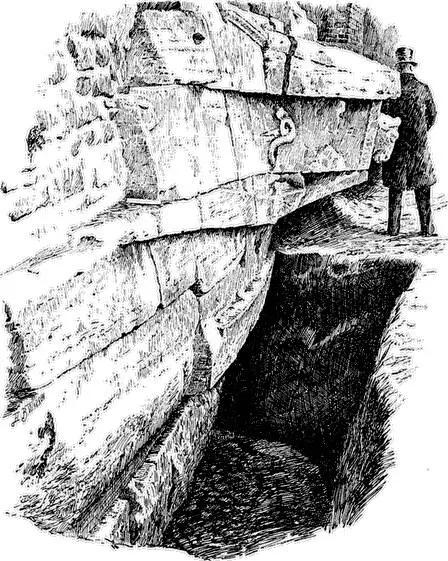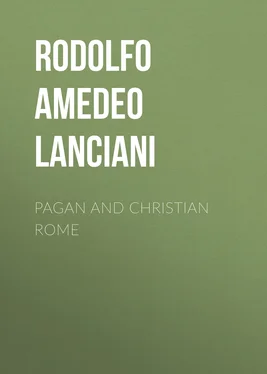Rodolfo Amedeo Lanciani - Pagan and Christian Rome
Здесь есть возможность читать онлайн «Rodolfo Amedeo Lanciani - Pagan and Christian Rome» — ознакомительный отрывок электронной книги совершенно бесплатно, а после прочтения отрывка купить полную версию. В некоторых случаях можно слушать аудио, скачать через торрент в формате fb2 и присутствует краткое содержание. Жанр: foreign_edu, История, История, на английском языке. Описание произведения, (предисловие) а так же отзывы посетителей доступны на портале библиотеки ЛибКат.
- Название:Pagan and Christian Rome
- Автор:
- Жанр:
- Год:неизвестен
- ISBN:нет данных
- Рейтинг книги:3 / 5. Голосов: 1
-
Избранное:Добавить в избранное
- Отзывы:
-
Ваша оценка:
- 60
- 1
- 2
- 3
- 4
- 5
Pagan and Christian Rome: краткое содержание, описание и аннотация
Предлагаем к чтению аннотацию, описание, краткое содержание или предисловие (зависит от того, что написал сам автор книги «Pagan and Christian Rome»). Если вы не нашли необходимую информацию о книге — напишите в комментариях, мы постараемся отыскать её.
Pagan and Christian Rome — читать онлайн ознакомительный отрывок
Ниже представлен текст книги, разбитый по страницам. Система сохранения места последней прочитанной страницы, позволяет с удобством читать онлайн бесплатно книгу «Pagan and Christian Rome», без необходимости каждый раз заново искать на чём Вы остановились. Поставьте закладку, и сможете в любой момент перейти на страницу, на которой закончили чтение.
Интервал:
Закладка:
Nemi and the site of the Temple of Diana.
A Platform of the Temple of Diana. B Village of Nemi and Castle of the Orsinis.
Portrait Bust of Person cured at Nemi.
The excavation of the temple of Diana Nemorensis was undertaken in 1885, by Sir John Savile Lumley, now Lord Savile of Rufford, the English ambassador at Rome, with the kind consent of the Italian government. It seems that this Artemisium Nemorense was not only a place of worship and devotion, but also a hydro-therapeutic establishment. The waters employed for the cure were those which spring from the lava rocks at Nemi, and which, until a few years ago, fell in graceful cascades into the lake, at a place called "Le Mole." They now supply the city of Albano, which has long suffered from water-famine. I can vouch for their therapeutic efficiency from personal experience; in fact I could honestly put up my votive offering to the long-forgotten goddess, having recovered health and strength by following the old cure. Diana, however, was chiefly worshipped in this place as Diana Lucina. I need not enter into particulars on this subject. The ex-votos collected in large quantity by Lord Savile, representing young mothers nursing their first-born, and other offerings of the same nature, testify to the skill of the priests. Perhaps they practised other branches of surgery, because, among the curiosities brought to light in 1885, are several figures with large openings on the front, through which the intestines are seen. Professor Tommasi-Crudeli, who has made a study of this class of curiosities, says that they cannot be considered as real anatomical models, because the work is too rough and primitive to enable us to distinguish one intestine from the other. The number of objects collected by Lord Savile may be estimated at three thousand.

The stern of the ship of the Island of the Tiber.
Characteristic objects of a like nature—breasts cut open and showing the anatomy—have been found in large numbers in and near the island of the Tiber, where the Temple of Æsculapius stood, at the stern of the marble ship. It seems that the street leading from the Campus Martius to the Pons Fabricius, and across it to the temple, was lined with shops and booths for the sale of ex-votos, as is the case now with the approaches to the sanctuaries of Einsiedeln, Lourdes, Mariahilf, and S. Jago. In the foundations of the new quays of the Tiber, above and below the bridge, the ex-votos have been found in regular strata along the line of the banks, whereas in the island itself they have come to light in much smaller quantities. As the votive objects deposited in this sanctuary, from the year 292 before Christ to the fall of the Empire, may be counted not by thousands, but by millions of specimens, I believe that the bed of the Tiber must have been used as a favissa .

Fragment of a Lamp inscribed with the name of Minerva.
The name of Minerva Medica is familiar to students and visitors of old Rome; 39but the monument which bears it, a nymphæum of the gardens of the Licinii, near the Porta Maggiore, has no connection whatever with the goddess of wisdom. Minerva Medica was the name of a street on the Esquiline, so called from a shrine which stood at the crossing, or near the crossing, with the Via Merulana, not far from the church of SS. Pietro e Marcellino. Its foundations and its deposit of ex-votos were discovered in 1887. The shape and nature of the offerings bear witness to numberless cases of recovery performed by the merciful goddess, the Athena Hygieia or Paionia of the Greeks. There is a fragment of a lamp inscribed with her name, which leaves no doubt as to the identity of the deposit. There is also a votive head, not cast from the mould, but modelled a stecco , which alludes to Minerva as a restorer of hair. The scalp is covered with thick hair in front and on the top, while the sides are bald, or showing only an incipient growth. It is evident, therefore, that the woman whose portrait-head we have found had lost her curls in the course of some malady, and having regained them through the intercession of Minerva, as she piously believed, offered her this curious token of gratitude. This, at least, is Visconti's opinion. Another testimonial of Minerva's efficiency in restoring hair has been found at Piacenza, a votive tablet put up MINERVÆ MEMORI by a lady named Tullia Superiana, RESTITUTIONE SIBI FACTA CAPILLORUM (for having restored her hair).
Votive Head.
As regards the multitude of ex-votos, no other temple or deposit discovered in my time can be compared with the favissæ of the Temple of Juno at Veii. In Roman traditions this temple was regarded as the place where Camillus emerged from the cuniculus , or mine, on the day of the capture of the city. The story runs that Camillus, having carried his cuniculus under the Temple of Juno within the citadel, overheard the Etruscan aruspex declare to the king of Veii that victory would rest with him who completed the sacrifice. Upon this, the Roman soldiers burst through the floor, seized the entrails of the victims, and bore them to Camillus, who offered them to the goddess with his own hand, while his followers were gaining possession of the city. The account is certainly more or less fabricated; but, as Livy remarks, "it is not worth while to prove or disprove these things." We are content to know that within the citadel of Veii, the "Piazza d' Armi" of the present day, there was a temple of great veneration and antiquity, and that it was dedicated to Juno. Both points have been proved and illustrated by modern discoveries.
The Cliffs under the Citadel of Veii (now called Piazza d' Armi).
The ex-votos of the Latin sanctuaries were, as I have just remarked, buried in the favissæ ; but at Veii, because of the danger and the difficulty of excavating them within the citadel, and in solid rock, the ex-votos were carted away and thrown from the edge of the cliff into the valley below. The place selected was the north side of the rocky ridge connecting the citadel with the city, which ridge towers one hundred and ninety-eight feet above the cañon of the Cremera. The mass of objects thrown over here in the course of centuries has produced a slope which reaches nearly to the top of the cliff. The reader will appreciate the importance of the deposit from the fact that the mine has been exploited ever since the time of Alexander VII. (1655-1667); and in the spring of 1889, when the most recent excavations were made, by the late empress Theresa of Brazil, the mass of terra-cottas brought to the surface was such that work had to be given up after a few days, because there was no more space in the farmhouse for the storage of the booty. Pietro Sante Bartoli left an account of the excavations made on the same spot by cardinal Chigi, during the pontificate of Alexander VII. Modern topographers do not seem to be aware of this fact; it is not mentioned by Dennis, or Gell, or Nibby, although it is the only evidence left of the discovery of the famous sanctuary. "Not far from the Isola Farnese a hill [the Piazza d' Armi], rises from the valley of the Cremera, on the plateau of which cardinal Chigi has discovered a beautiful temple with fluted columns of the Ionic order. The frieze is carved with trophies and panoplies of various kinds; the reliefs of the pediment represent the emperor Antoninus[?] sacrificing a ram and a sow, and although the panels lie scattered around the temple, and the figures are broken, apparently no important piece is missing. There is also an altar four feet high, with figures of Etruscan type, which was removed to the Palazzo Chigi [now Odescalchi]. The columns and marbles of the temple were bought by cardinal Falconieri to build and ornament a chapel in the church of S. Giovanni de' Fiorentini.... Not far from the temple a stratum of ex-votos has been found, so rich that the whole of Rome is now overrun with terra-cottas. Every part of the human body is represented,—heads, hands, feet, fingers, eyes, noses, mouths, tongues, entrails, lungs, symbols of fecundity, whole figures of men and women, horses, oxen, sheep, pigs,—in such quantities as to make several hundred cartloads. There were also bronze statuettes, sacred utensils, and mirror-cases, which were all stolen or destroyed. I have known of one workman breaking marvellous objects ( cose insigni ) into small fragments to melt them into handles for knives."
Читать дальшеИнтервал:
Закладка:
Похожие книги на «Pagan and Christian Rome»
Представляем Вашему вниманию похожие книги на «Pagan and Christian Rome» списком для выбора. Мы отобрали схожую по названию и смыслу литературу в надежде предоставить читателям больше вариантов отыскать новые, интересные, ещё непрочитанные произведения.
Обсуждение, отзывы о книге «Pagan and Christian Rome» и просто собственные мнения читателей. Оставьте ваши комментарии, напишите, что Вы думаете о произведении, его смысле или главных героях. Укажите что конкретно понравилось, а что нет, и почему Вы так считаете.












